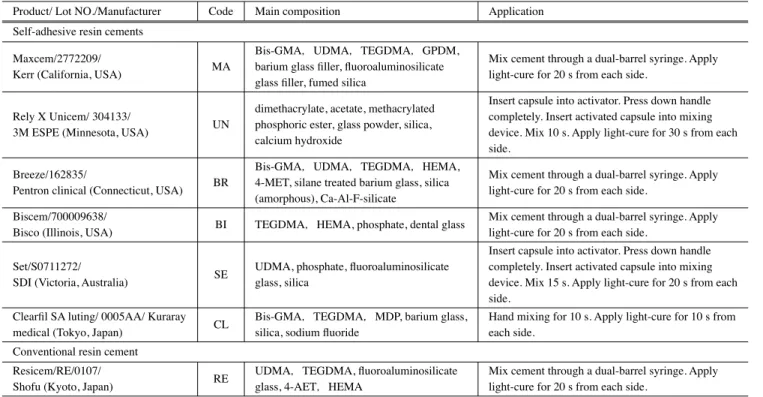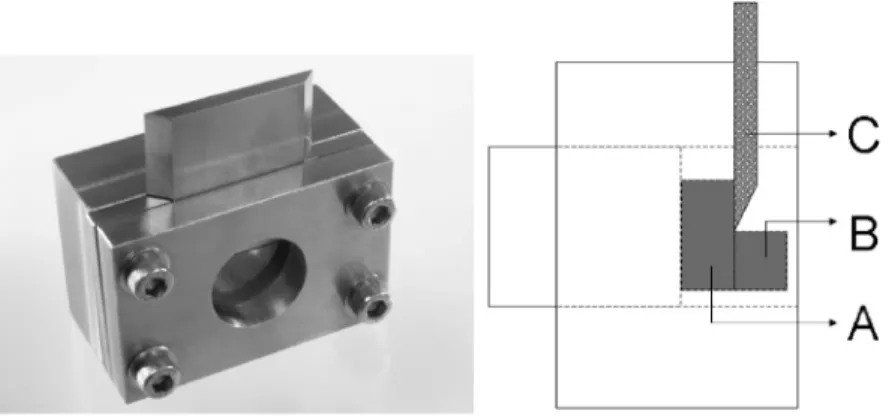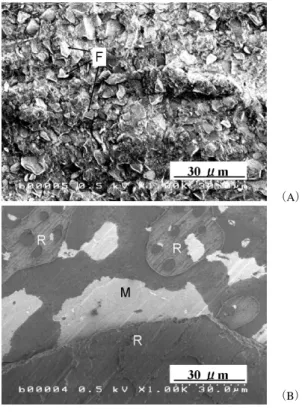Ⅰ.緒 言 歯科用金属は,インレー,クラウン,ブリッジなどの 歯冠修復用材料,ブラケットなどの矯正用材料およびイ ンプラント材料として使用されており,種々の使用目的 に適応するように鋳造,加工,あるいは既製品として供 給されている1, 2). 歯冠修復装置を長期間機能させるには,修復材料が歯 質や他の材料と接着し辺縁漏洩を防止することがきわめ て重要である.Nakabayashi ら3),Hotta ら4)は,接 着することにより,必要最小限の歯質削除の治療が可能 であると報告している. 歯科用金属の一般的な接着方法は,合金に表面処理を 施した後,接着性レジンやセメントを用いて行う. 1980 年代初期に金属の接着法が報告された以来,接着 材料の改良とともに各歯冠修復材料の接着理論と材料耐 久性も明らかになった5‒13).歯科用合金には貴金属合金 と非貴金属合金があるので,それに対応した接着方法を 採 用 し て い る. 非 貴 金 属 合 金 に お け る 接 着 は, 4-META,MAC-10,MDP などの接着性モノマーとの 反応性が高い非貴金属酸化物の薄膜を介したシステムで 行われている.一方,貴金属プライマーはトリアジンジ チオン系(VBATDT),チオウラシル系(MTU-6)な 日本歯科大学生命歯学部歯科補綴学第 2 講座
Department of Crown and Bridge, School of Life Dentistry, The Nippon Dental University 受付:2010 年 4 月 14 日/受理:2010 年 7 月 30 日
Received on April 14, 2010/Accepted on July 30, 2010
原 著 論 文
セルフアドヒーシブレジンセメントの歯冠修復用金属に対する接着強さに
及ぼす影響
米沢 弥生,林 捷,新谷 明喜
Effect of Self-adhesive Resin Cement on Bond Strength to Restorative Metal Materials
Yayoi Yonezawa, DDS, PhD, Jie Lin, BDS and Akiyoshi Shinya, DDS, PhD
抄 録
目的:6 種類のセルフアドヒーシブレジンセメントの歯冠修復用金属との接着強さについて検討した. 方法:本研究では,被着体として,チタン,ニッケルクロム合金,金合金,金銀パラジュウム合金,陶材 焼付用金合金の 5 種類を使用した.接着材は,セルフアドヒーシブレジンセメントの Maxcem(Kerr, MA),Unicem(3M ESPE,UN),Breeze(Pentron Clinical, BR),Biscem(Bisco, BI),Set(SDI, SE),Clearfi l SA luting(Kuraray, CL)の 6 種類および従来型のレジンセメントの Resicem(Shofu, RE)を選択した.すべての試験片は,ランダマイズして 7 群に分け(n = 6),耐水研磨紙# 600 で研磨 した後,各接着材のメーカー指示に従い,被着体ブロックの接着を行った.接着後,ただちに 37℃恒温 槽内で水中浸漬し,24 時間保存した.材料試験機にてローディングスピード 0.5 mm/min. で荷重をかけ, 最大圧縮せん断強さを測定した.測定値は,Kruskal-Wallis 検定と Wilcoxon rank sum 検定により統計 処理を行った.破断した試験片は,走査電子顕微鏡を用いて試験片の破断面を観察した.
結果:圧縮せん断接着強さの平均値は,タイプ III 金合金で 2.6 ± 1.9 MPa,金銀パラジウム合金で 2.2 ± 1.7 MPa,陶材焼付用金合金で 5.0 ± 2.3 MPa,チタンで 10.2 ± 5.4 MPa,ニッケルクロム合金で 9.9 ± 7.8 MPa を示した. 結論:セルフアドヒーシブレジンセメントの歯冠修復用金属に対する接着強さは,貴金属が非貴金属より 顕著に小さい値を示し,前処理の必要性が示唆された.BR,BI,CL では,非貴金属に対して他のセメン トより高い接着強さを示した. 和文キーワード セルフアドヒーシブレジンセメント,接着強さ,歯冠修復用金属
どメルカプト基(-SH)を含有するため,貴金属の新鮮 面にダイレクトに接着することが特徴で,酸化物の薄膜 を介するシステムとは全く異なった接着機構を示す.ま た,金属表面を機械的に処理し,凹凸を付与することに より,接着材料がそれらの凹みに浸入,硬化することで 両者が機械的に保持されながら接着させる方法が一般的 である. 最近開発されたセルフアドヒーシブレジンセメント は,チェアータイムの短縮だけではなく,被着体の種類 およびテクニックセンシティブなどによる影響が少ない とされている14‒17).このセメントはセルフエッチング・ セルフアドヒーシブ作用をもち,前処理なしで歯質だけ でなくあらゆる修復材料に接着性を発揮するといわれて いる18‒20).しかし,これら接着材の歯冠修復用金属に 対する接着強さ,破壊形態については,明確な結論を得 るには至っていないのが現状である. 修復装置を長期間機能させるには,歯質と接着材,歯 冠修復用金属と接着材それぞれの接着界面の接着挙動を 解明する必要がある.前報では,セルフアドヒーシブレジ ンセメントのエナメル質に対する接着挙動を報告した21). そこで本研究は,セルフアドヒーシブレジンセメントの 各種歯冠修復用金属に対する接着強さについて検討した. Ⅱ.材料と方法 1. 接着材料 本研究で使用した接着材料を表 1 に示す.接着材には, 6 種類のセルフアドヒーシブレジンセメント(Maxcem [MA],Rely X Unicem[UN],Breeze[BR],
Biscem[BI],Set[SE],Clearfil SA luting[CL])
および 1 種類の従来型レジンセメント Resicem(RE) を使用した.
2. 試験片の作製
金 属 に は,JIS 第 1 種 純 チ タ ン(T-Alloy, GC,
Tokyo, Japan), ニ ッ ケ ル ク ロ ム 合 金(Uni metal
EZ,Shofu, Tokyo, Japan),タイプ III 金合金(Casting
gold type 3,Ishifuku metal industry, Tokyo,
Japan), 金 銀 パ ラ ジ ウ ム 合 金(Kinpara best 12,
Ishifuku metal industry, Tokyo, Japan),陶材焼付 用金合金(Jupiter H,Ishifuku metal industry, Tokyo, Japan)を用いた.5 種類の歯冠修復用金属の組成を表 2 に示す.
試験片には,10 × 10 × 20 mm(A)および 10 × 10 × 10 mm(B)のブロックを作製し,ランダマイズ
して 7 群に分け(n = 6),被着面は耐水研磨紙 #600
Buehler(#600,Sankei, Tokyo, Japan)を 用 い て 一方向に研磨したのち,アセトンおよび精製水にて各 15 分間超音波洗浄を行って接着阻害因子を除去し,大 気中で自然乾燥させた. 5 種類の歯冠修復材料と 7 種類のレジンセメントの組 み合せ 35 条件を設定し,それぞれ繰り返し 6 回,計 210 回の実験をランダマイズして行った. 3. 接着操作 レジンセメントの使用方法は,表 1 に示す.ブロッ クの両被着面に接着材を塗布した後,被着面の研磨方向 を一致させ,接着した.定荷重試験機(Seiki, Tokyo, Japan)を用いて 147 N,15 分の条件で荷重を加え, 接着部から溢出した余剰レジンを技工用ナイフで除去し た.LED 照射器(G-Light, GC)を使用し接着部境界 に両面で光照射を荷重中に行った.接着実験条件は ISO/TR 11405 に準じた22).接着した試験片は,ただ ちに 37℃恒温漕内で水中浸漬し,24 時間保存した. 4. 圧縮せん断試験 圧縮せん断接着試験は,図 1 に示す圧縮せん断試験装 置を材料試験機(Servopulser EHF-FD1,Shimadzu, Kyoto, Japan)に接続して行った.接着強さの測定は, 測定装置に試験片を挿入して接着面に沿って荷重を加 え,試験片の接着部が破壊するときの最大荷重(N)を 測定し,これを接着面積(100 mm2)で除した値を接 着強さ(MPa)とした.なお,荷重速度は 0.5 mm/min とした. 統計ソフト(SPSS Version 10.0,SPSS,Chicago, USA)を用いて圧縮せん断接着強さの統計処理を行っ た.測定値は Kolmogorov-Smirnov の正規性検定にて, 正規分布に従わない,また Bartlett's 検定により等分散 していないことが判明したので,ノンパラメトリックの 統 計 方 法 を 選 択 し た.Kruskal-Wallis 検 定( α =
0.05)をしたのち,Wilcoxon rank sum 検定を行った.
多 重 比 較 の 結 果 は Bonferroni 補 正 法 で 補 正 し た. Bonferroni 補正法で補正した有意水準について,同一 金属材料の各接着材の間はα= 0.05/21 㲈 0.0024,同 一接着材の各金属材料の間はα= 0.05/10 = 0.005 と した. 5. 破壊形態および SEM の観察 破壊形態は,界面破壊を I 型,セメントの凝集破壊を II 型,被着体破壊を III 型とした.せん断試験にて破断 した被着体表面の試験片を白金蒸着(Ion sputter E-1030,Hitachi, Tokyo, Japan)したのち,走査電
補綴03-01/04原著t.再.indd 2
子顕微鏡(S-4000)を用いて加速電圧 5 kV にて試験 片の破断面を観察した.
6. エックス線回折(XRD)
貴金属と非貴金属の表面酸化膜の違いを特定するため に,エックス線回折装置(RINT 1400,Rigaku Denki, Tokyo, Japan)を用いて,以下に示すような条件で各 種金属表面の測定を行った.条件はターゲット:Cu, フィルター:Ni,電圧:40 kV,電流:80 mA,コリ メーター:100 uml,測定角度:5-80 ,スキャンスピ ード:8 /min に設定した.試料は入射エックス線に対 する傾き方向と面方向の 2 軸回転をかけながら測定を 行った. Ⅲ.結 果 1. 圧縮せん断接着強さ 圧縮せん断接着強さの結果を図 2 に示す.Kruskal-Wallis 検定によりセメント種類( < 0.01)と被着体 種類( < 0.01)に有意差が認められた.接着強さの 中央値,平均値,標準偏差(MPa)および多重比較検 定の結果を表 3 に示す.被着金属別の接着強さの平均 値は,タイプ III 金合金で 2.6 ± 1.9 MPa,金銀パラ ジウム合金で 2.2 ± 1.7 MPa,陶材焼付用金合金で 5.0 ± 2.3 MPa,チタンで 10.2 ± 5.4 MPa,ニッケ ルクロム合金で 9.9 ± 7.8 MPa を示した.
表 1 List of resin cements used in this study 実験に使用した接着材料
Product/ Lot NO./Manufacturer Code Main composition Application
Self-adhesive resin cements Maxcem/2772209/
Kerr (California, USA) MA
Bis-GMA,UDMA,TEGDMA,GPDM, barium glass fi ller, fl uoroaluminosilicate glass fi ller, fumed silica
Mix cement through a dual-barrel syringe. Apply light-cure for 20 s from each side.
Rely X Unicem/ 304133/
3M ESPE (Minnesota, USA) UN
dimethacrylate, acetate, methacrylated phosphoric ester, glass powder, silica, calcium hydroxide
Insert capsule into activator. Press down handle completely. Insert activated capsule into mixing device. Mix 10 s. Apply light-cure for 30 s from each side.
Breeze/162835/
Pentron clinical (Connecticut, USA) BR
Bis-GMA,UDMA,TEGDMA,HEMA, 4-MET, silane treated barium glass, silica (amorphous), Ca-Al-F-silicate
Mix cement through a dual-barrel syringe. Apply light-cure for 20 s from each side.
Biscem/700009638/
Bisco (Illinois, USA) BI TEGDMA,HEMA, phosphate, dental glass
Mix cement through a dual-barrel syringe. Apply light-cure for 20 s from each side.
Set/S0711272/
SDI (Victoria, Australia) SE
UDMA, phosphate, fl uoroaluminosilicate glass, silica
Insert capsule into activator. Press down handle completely. Insert activated capsule into mixing device. Mix 15 s. Apply light-cure for 20 s from each side.
Clearfi l SA luting/ 0005AA/ Kuraray
medical (Tokyo, Japan) CL
Bis-GMA,TEGDMA,MDP, barium glass, silica, sodium fl uoride
Hand mixing for 10 s. Apply light-cure for 10 s from each side.
Conventional resin cement Resicem/RE/0107/
Shofu (Kyoto, Japan) RE
UDMA,TEGDMA, fl uoroaluminosilicate glass, 4-AET,HEMA
Mix cement through a dual-barrel syringe. Apply light-cure for 20 s from each side.
Bis-GMA: Bisphenol-A-diglycidyl methacrylate; GPDM: Glycerol dimethacrylate dihydrogen phosphate; HEMA: 2-hydroxyethyl methacrylate; MDP: 10-methacryloyloxy-decyl dihydrogenphosphate; MMA: Methyl methacrylate; TEGDMA: Triethyleneglycol dimethacrylate; UDMA: urethane dimethacrylate; 4-AET: 4-acryloxyethyltrimellitic acid; 4-MET: 4-methacryloxyethyl trimellitic acid.
表 2 List of adherend samples in this study 実験に使用した被着体材料
Materal Brand name Composition (wt% ) Manufacturer
Titanium T-Alloy Ti 99, others 1 GC,Tokyo, Japan
Nickel-chromium alloy Uni metal EZ Ni 61, Cr 25, Mn 11, others 3 Shofu, Kyoto, Japan
Gold alloy type 3 Casting gold type 3 Au 74, Ag 10, Cu 10, others 6 Ishifuku metal industry, Tokyo, Japan Silver-palladium-copper-gold alloy Kinpara best 12 Au 12, Ag 46, Cu 19, Pd 20, others 3 Ishifuku metal industry, Tokyo, Japan Metal-ceramic gold alloy Jupiter H Au 75, Ag 2, Pd 12, Pt 7, others 4 Ishifuku metal industry, Tokyo, Japan
材料別による各セメントの多重比較結果は,チタンお よびニッケルクロム合金の BR,BI,CL と他のセメン トとの間で有意差が認められた.被着金属別の多重比較 結果では,非貴金属のチタン,ニッケルクロム合金と貴 金属の金合金,金銀パラジュウム合金,陶材焼付用金合 金の間に有意差が認められ,非貴金属のほうが有意に高 い値を示した. 2. 破壊形態および SEM の観察 破壊形態の結果を表 4 に示す.図 3 に破断面 SEM 像 を示す.破壊形態は,チタン,ニッケルクロム合金の BR,CL では,接着材層の凝集破壊が試験片の半分以上 を示した.これら以外のすべての組み合せで界面破壊を 示した.また,いずれの場合も被着ブロック内での凝集 破壊は認められなかった. 3. エックス線回折 チタンと陶材焼付金合金のエックス線回折パターンを 図 4 に示す.チタン合金の表面酸化物の成分 TiO2はエ ックス線回折で同定された(図 4A).図 4B に示す貴金 属の Pt, Au, Ag の酸化物が同定され,CuO と思われ るピークの成分が同定できなかった.酸化膜のエックス 線回折により貴金属と非貴金属の表面酸化膜成分の違い が特定できた.
図 1 Test device for determination of shear bond strength A: Block of 10×10×20 mm, B: Block of 10×10×10 mm, C: Sliding block
圧縮せん断接着強さ測定装置
A:10×10×20 mm ブロック,B:10×10×10 mm ブロック, C:スライディングブロック
図 2 Box plots of the shear bond strength results 圧縮せん断接着強さの結果
補綴03-01/04原著t.再.indd 4
Ⅳ.考 察 本実験では,セルフアドヒーシブレジンセメントと歯 冠修復用金属との間の化学的接着力を測るために,機械 的嵌合力の影響をできるだけ少なくし,サンドブラスト ではなく,耐水研磨紙 #600 研磨を使用した.コント ロールとして使用した従来型のレジンセメントの RE は,微量の 4-AET を含有しているが,被着体の化学的 結合まで期待されていない. 1. 非貴金属 現在,歯科用金属の接着に使用されている接着性モノ マーは,官能基の種類によってリン酸エステル系,カル ボン酸系,硫黄系の三つに分類される5, 10‒13).前二者 は非貴金属に有効で,後者は貴金属に効果がある23, 24). 非貴金属のニッケルクロム合金の BR,BI,CL では, それぞれ接着性モノマーを含有するため,他の 4 種類 セメントと有意の差をもって高い値を示した.チタンに 対する接着強さも同様な傾向を示した.非貴金属に有効 なモノマーは,カルボン酸(-COOH)や 2 価のリン酸 (-PO(OH)2)などの酸性官能基をもつ.図 4A に示すチ タンのエックス線回折図形には,下地のチタンからの強 い回折ピークが観察されている.その回折図形を解析処 理して,下地のチタンからの回折ピークを除去し,表面 皮膜由来のみと考えられる 2 θ =20 deg. 付近に,強 度の弱いピークが明瞭に観察できた.非貴金属表面を大 気に曝した場合,ただちに酸素と反応して 1-3 nm の 厚さの酸化物層が形成される.さらにその酸化物層は大 気中の水と反応し,表面は水酸基(-OH)により覆われ
表 3 Bond strength of medians, means, standard deviations in MPa and the results of multiple comparison 接着強さの中央値,平均値,標準偏差(MPa)および多重比較検定の結果
Groups Titanium Nickel-chromium alloy Gold alloy type 3
Silver-palladium-copper-gold alloy Metal-ceramic gold alloy Medians Means±SD Medians Means±SD Medians Means±SD Medians Means±SD Medians Means±SD
MA 9.3A c 9.4±1.8 6.8AB b 6.1±2.3 0.3A a 0.3±0.2 0.3A a 0.3±0.3 5.1AB b 4.8±1.5 UN 4.6B ab 4.7±0.6 5.1AB ab 5.3±2.1 3.5B ac 3.5±0.9 2.6B c 2.5±0.6 6.2A b 6.0±1.2 BR 15.7C b 14.4±4.3 14.1C b 15.2±3.8 5.7E a 5.4±0.9 5.8C a 5.6±0.9 8.7D a 8.8±1.4 BI 15.0C b 14.1±3.4 11.9AC b 11.6±3.3 0.3AC a 0.5±0.5 0.5A a 0.6±0.5 4.0ABC a 4.0±0.7 SE 6.0AB b 6.2±1.4 0.7B a 0.8±0.6 1.8CD a 1.7±0.9 1.8B a 2.0±0.8 2.5C a 2.6±1.4 CL 17.3C b 17.6±2.8 25.4D c 23.5±7.1 3.7B a 3.8±0.5 2.5B a 2.5±0.4 5.7A a 5.9±1.2 RE 5.6AB bc 5.2±1.2 6.5AB c 6.6±2.1 2.6BD a 2.7±0.5 2.0B a 2.0±0.4 3.1BC ab 3.2±0.9 Kruskal-Wallis test followed by pairwise comparison using the Wilcoxon test modifi ed by Bonferroni (p>0.05). Within the same column, medians with the same upper case superscript letter are not statistically different. Within the same row, medians with the same lower case subscript letter are not statistically different.
Wilcoxon rank sum検定の結果は Bonferroni 法で修正した(p > 0.05).同一列に同じ上付き,同一行に同じ下付きのアルファベットは有意差の
ないことを示す.
表 4 Failure mode distribution recorded in the experimental groups 破壊形態の結果
Titanium Nickel-chromium
alloy Gold alloy type 3
Silver-palladium-copper-gold alloy Metal-ceramic gold alloy MA 3/3/0 6/0/0 6/0/0 6/0/0 6/0/0 UN 6/0/0 6/0/0 6/0/0 6/0/0 6/0/0 BR 2/4/0 1/5/0 6/0/0 6/0/0 6/0/0 BI 3/3/0 6/0/0 6/0/0 6/0/0 6/0/0 SE 6/0/0 6/0/0 6/0/0 6/0/0 6/0/0 CL 0/6/0 0/6/0 6/0/0 6/0/0 6/0/0 RE 6/0/0 6/0/0 6/0/0 6/0/0 6/0/0
The fractured interfaces on the samples were examined and classify into one of three categories. The number of each failure mode was recorded by the following form: Type I (interfacial failure) / Type II (cohesive failure in resin cement) / Type III (cohesive failure in adherend block).
本表は各被着金属とレジンセメントにおいて観察された破壊形態のタイプと個数を示す.表中の破 壊形態のタイプと個数の表示は以下の順に記載した:I 型(界面破壊)/II 型(セメントの凝集破壊) /III型(被着体破壊).
る25, 26).4-META,MDP などの接着性モノマーと非 貴金属の接着機構は水素結合が重要な役割を果たしてい ると考えられる.従来型のレジンセメント RE は,接着 性モノマー 4-AET の含有濃度が低いため,BR,BI, CL より低い接着強さ(6.6 ± 2.1 MPa)を示した.現 状で最も高い接着性能が得られるシステムは,Taira ら24) が報告した,非貴金属用接着プライマーと 4-META 接 着性レジンを組み合わせたものである.しかし,サンド ブラストなどの機械的嵌合力を付与していない場合は, 熱サイクルによる耐久性試験を行うと,かなりの接着強 さの低下が認められた. 2. 貴金属 接着ブリッジ用の合金はかつてニッケルクロム合金や コバルトクロム合金などの非貴金属が機械的強さや接着 強さの大きい利点から使用されてきたが,より鋳造精度 に優れ,操作性の良い貴金属として金合金タイプ IV, 金銀パラジウム合金を使用することが勧められる5). 本実験の結果では,3 種類の貴金属に対して,セルフ アドヒーシブレジンセメントに添加した接着性モノマー (MDP,4-META など)にはさほど寄与せず,ほかの 被着体より低い値を示した.貴金属,非貴金属両用の接 着材として,それぞれ専用の接着性モノマーを併用する 方法が考えられるが,セルフアドヒーシブレジンセメン トの製品では,各種接着性モノマーの共存安定性,濃度 のバランス,セメントの重合性能,強度などを考慮しな ければならない.現在市販されているセルフアドヒーシ ブレジンセメントには,貴金属接着性モノマーを含んで いない.その原因は,金属接着性モノマーのなかには, 接着材中に添加すると還元剤と反応して硬化しなくなっ たり,逆に保存中に重合開始や連鎖移動反応を起こすな
図 4 X-ray diff raction patterns of the titanium (A) and metal-ceramic gold alloy (B) tested
チタン(A)と陶材焼付用金合金(B)のエックス線 回折結果 1500 1000 500 0 10 20 30 40 50 60 70 80 強度 ( counts ) 2θ(deg) 強度 ( counts ) 2θ(deg) 1250 1000 500 250 750 0 10 20 30 40 50 60 70 80 (A) (B)
図 3 Typical SEM microphotographs of titanium-CL and metal-ceramic gold alloy-MA
(A) Cohesive failure of a MDP monomer containing resin cement (CL) luted to a titanium surface, remaining cement and fi llers can be observed onto the alloy surface.
(B) Pure adhesive failure of a MA specimen bonded to a metal-ceramic gold alloy surface. F: fi ller, R: resin cement, M: metal-ceramic gold alloy. チタン-CL と陶材焼付用金合金-MA の破断面 SEM 像 (A)チタン-CL では,接着材層の凝集破壊を示し, 破壊面全体にセメントとフィラーの残留が観察され た. (B)陶材焼付用金合金 -MA では,界面破壊を示した. F:フィラー,R:レジンセメント,M:陶材焼付用 金合金. (A) (B) 補綴03-01/04原著t.再.indd 6 補綴03-01/04原著t.再.indd 6 10.11.30 9:54:21 AM10.11.30 9:54:21 AM
ど,化学的安定性に悪影響をおよぼす組み合せがある. これを避けるために,金属接着性モノマーを溶媒に溶か して接着材本体と別にしたものが金属接着用プライマー である.Taira ら13),Fonseca ら27)の報告ではアロイ プライマーは貴金属と非貴金属両方に対し,安定した接 着強さを示した.今回の実験ではセルフアドヒーシブレ ジンセメントの貴金属に対する接着強さは,非貴金属よ り顕著に小さい値を示した.貴金属に対する接着は,こ れらのセルフアドヒーシブレジンセメントに含まれる貴 金属用の接着性モノマーがなければ成り立たないので, サンドブラスト,また金属接着プライマーを塗布するこ とが推奨される28, 29). Ⅴ.結 論 本研究では,7 種類のセルフアドヒーシブレジンセメ ントの接着強さに及ぼす 5 種類の歯冠修復用金属によ る影響を明らかにするために実験を行い,圧縮せん断接 着強さおよび破壊形態について評価を行った.その結果, セルフアドヒーシブレジンセメントの歯冠修復用金属に 対する接着強さは,貴金属が非貴金属より顕著に小さい 値を示し,前処理の必要性が示唆された.BR,BI,CL では,非貴金属に対して他のセメントより高い接着強さ を示した. 文 献
1) Mccabe JF,Walls AW. Applied dental materials, 9th ed. Oxford: Blackwell; 2008, 53‒89.
2) Weinsten M,Katz S,Weinstein AB. Fused porcelain-to-metal teeth. US Patent 3,052,982, September 11, 1962.
3) Nakabayashi N,Masuhara E. Development of adhesive pit and fissure sealants using a MMA resin initiated by a tri-n-butyl borane derivative. J Biomed Mater Res 1978; 12: 149‒165.
4) Hotta K,Mogi M,Miura F,Nakabayashi N. Eff ect of 4-MET on bond strength and penetration of monomers into enamel. Dent Mater 1992; 8: 173‒175.
5) Matsumura H,Varga J,Masuhara E. Composite type adhesive opaque resin. Dent Mater J 1986; 5: 83‒90.
6) Aksu MN,Powers JM,Lorey RE,Kolling JN. Variables aff ecting bond strength of resin-bonded bridge cements. Dent Mater 1987; 3: 26‒28. 7) Ekstrand K,Ruyter IE,Oysasd H. Adhesion to
titanium of methacrylate-based polymer materials. Dent Mater 1988; 4: 111‒115.
8) Matsumura H,Nakabayashi N. Adhesive 4-META/
M M A -T B B o p a q u e r e s i n w i t h p o l y ( m e t h y l methacrylate)-coated titanium dioxide. J Dent Res 1988; 67: 29‒32.
9) Tanaka T,Hirano M,Kawahara M,Matsumura H, Atsuta M. A new ion-coating surface treatment of alloys for dental adhesive resins. J Dent Res 1988; 67: 1376‒1380.
10) Matsumura H,Yoshida K,Tanaka T,Atsuta M. Adhesive bonding of titanium with a titanate coupler and 4-META/MMA-TBB opaque resin. J Dent Res 1990; 69: 1614‒1616.
11) Matsumura H,Kawahara M,Tanaka T,Atsuta M. Surface preparations for metal frameworks of composite resin veneered prostheses made with an adhesive opaque resin. J Prosthet Dent 1991; 66: 10‒15.
12) Taira Y,Matsumura H,Yoshida K,Tanaka T, Atsuta M. Adhesive bonding to dentin with ferrous chloride primers and tri-n-butylborane-initiated luting agents. J Dent Res 1996; 75: 1859‒1864. 13) Taira Y,Kamada K. Eff ects of primers containing
sulfur and phosphate monomers on bonding type IV gold alloy. J Dent 2008; 36: 595‒599.
14) Burke FJ,Fleming GJ,Abbas G,Richter B. Eff ectiveness of a self-adhesive resin luting system on fracture resistance of teeth restored with dentin-bonded crowns. Eur J Prosthodont Restor Dent 2006; 14: 185‒188.
15) Goracci C,Cury AH,Cantoro A,Papacchini F, Tay FR,Ferrari M. Microtensile bond strength and interfacial properties of etching and self-adhesive resin cements used to lute composite onlays under different seating forces. J Adhes Dent 2006; 8: 327‒335.
16) Abo-Hamar SE,Hiller KA,Jung H,Federlin M, Friedl KH,Schmalz G. Bond strength of a new universal self-adhesive resin luting cement to dentin and enamel. Clin Oral Investig 2005; 9: 161‒167.
17) Blatz MB,Chiche G,Holst S,Sadan A. Infl uence of surface treatment and simulated aging on bond strengths of luting agents to zirconia. Quintessence Int 2007; 38: 745‒753.
18) Mazzitelli C,Monticelli F,Osorio R,Casucci A, Toledano M,Ferrari M. Eff ect of simulated pulpal pressure on self-adhesive cements bonding to dentin. Dent Mater 2008; 24: 1156‒1163.
19) Escribano N, de la Macorra JC. Microtensile bond strength of self-adhesive luting cements to ceramic. J Adhes Dent 2006; 8: 337‒341.
20) Fabianelli A,Goracci C,Bertelli E,Monticelli F, Grandini S,Ferrari M. In vitro evaluation of
wall-to-wall adaptation of a self-adhesive resin cement used for luting gold and ceramic inlays. J Adhes Dent 2005; 7: 33‒40.
21) 林 捷,新谷明喜.セルフアドヒーシブレジンセメント のエナメル質に対する接着強さに及ぼす表面処理の影響. 歯材器 2009; 28: 178‒184.
22) ISO/TS 11405-2003, Dental Materials-Testing of adhesion to tooth structure. International Organization for Standardization, 2003.
23) Matsumura H,Kamada K,Tanoue N,Atsuta M. Eff ect of thione primers on bonding of noble metal alloys with an adhesive resin. J Dent 2000; 28: 287‒293.
24) Taira Y,Yoshida K,Matsumura H,Atsuta M. Phosphate and thiophosphate primers for bonding prosthodontic luting materials to titanium. J Prosthet Dent 1998; 79: 384‒388.
25) Kern M,Thompson VP. Durability of resin bonds to a cobalt-chromium alloy. J Dent 1995; 23: 47‒ 54.
26) Plueddemann EP. Silane Coupling Agents, 2nd ed. New York: Plenum; 1990, 94‒98.
27) Fonseca RG, de Almeida JGdSP,Haneda IG, Adabo GL. Effect of metal primers on bond strength of resin cements to base metals. J Prosthet Dent 2009; 101: 262‒268.
28) Watanabe I,Matsumura H,Atsuta M. Effect of two metal primers on adhesive bonding with type IV gold alloys. J Prosthet Dent. 1995; 73: 299‒ 303.
29) Petrie CS,Eick JD,Williams K,Spencer P. A comparison of 3 alloy surface treatments for resin-bonded prostheses. J Prosthodont. 2001; 10: 217‒ 223. 著者連絡先:新谷 明喜 〒 102-8159 東京都千代田区富士見 1-9-20 TEL: 03-3261-5738 FAX: 03-3261-5738 E-mail: cb-ndu@tky.ndu.ac.jp 補綴03-01/04原著t.再.indd 8 補綴03-01/04原著t.再.indd 8 10.11.30 9:54:23 AM10.11.30 9:54:23 AM
Effect of Self-adhesive Resin Cement on Bond Strength to Restorative Metal
Materials
Yayoi Yonezawa, DDS, PhD, Jie Lin, BDS and Akiyoshi Shinya, DDS, PhD
Department of Crown and Bridge, School of Life Dentistry, The Nippon Dental University
Ann Jpn Prosthodont Soc 3 : 1-9, 2011
ABSTRACT
Purpose: The aim of this study was to evaluate the shear bond strength of six self-adhesive resin cements to fi ve restorative metal materials.
Methods: Five restorative metal materials blocks were obtained by casting and polishing with #600 silicon carbide papers: (1) Titanium, (2) Nickel-chromium alloy, (3) Gold alloy type 3, (4) Silver-palladium-copper-gold alloy, (5) Metal-ceramic gold alloy. The following six self-adhesive resin cements: Maxcem (MA), Unicem (UN), Breeze (BR), Biscem (BI), Set (SE), Clearfi l SA luting (CL) and and one conventional resin cement: Resicem (RE) were used to bond to fi ve restorative metal materials in this study. Prior to testing specimens were stored in distilled water (37℃ ) for 24 h. The bond strength tests were performed in a universal testing machine (cross-head speed: 0.5 mm/min). Data were analyzed using Kruskal-Wallis test and the Wilcoxon rank sum test for multiple pairwise comparisons. Failure modes were recorded and the interfacial morphologys of debonded specimens were obser ved using a scanning electron microscope (SEM).
Results: The mean values of shear bond strength were 2.6 1.9 MPa for gold alloy type 3, 2.2 1.7 MPa for silver-palladium-copper-gold alloy, 5.0 2.3 MPa for metal-ceramic gold alloy, 10.2 5.4 MPa for titanium, 9.9 7.8 MPa for nickel-chromium alloy.
Conclusion: It can be concluded that self-adhesive resin cement is not suitable to bond noble metal without surface treatment. The shear bond strengths of BR, BI, CL to non-precious metals were signifi cantly higher than other resin cements.
Key words



